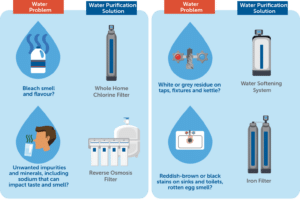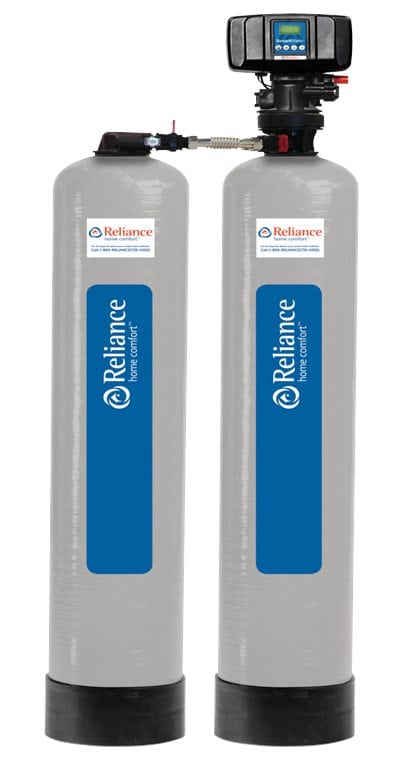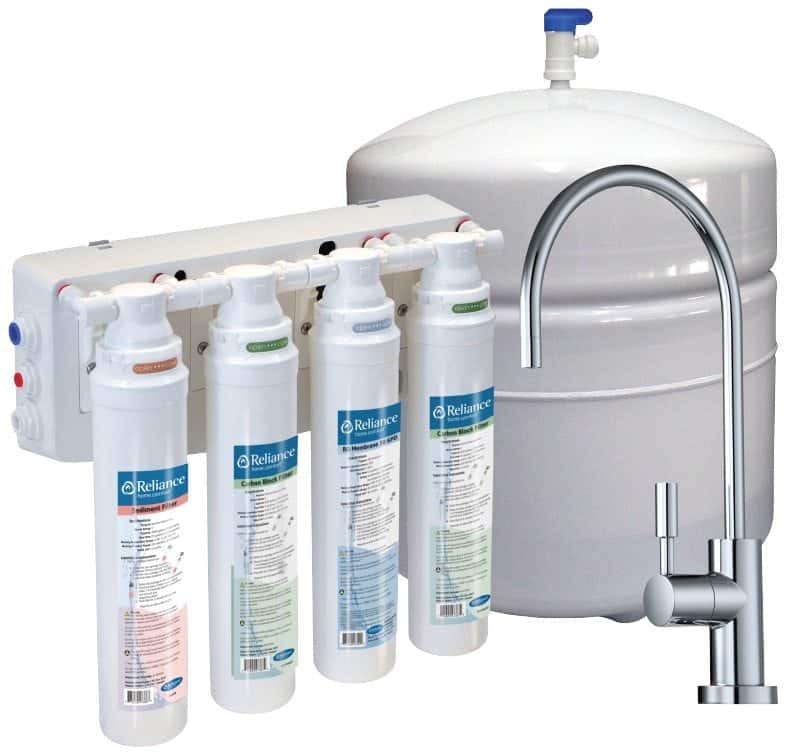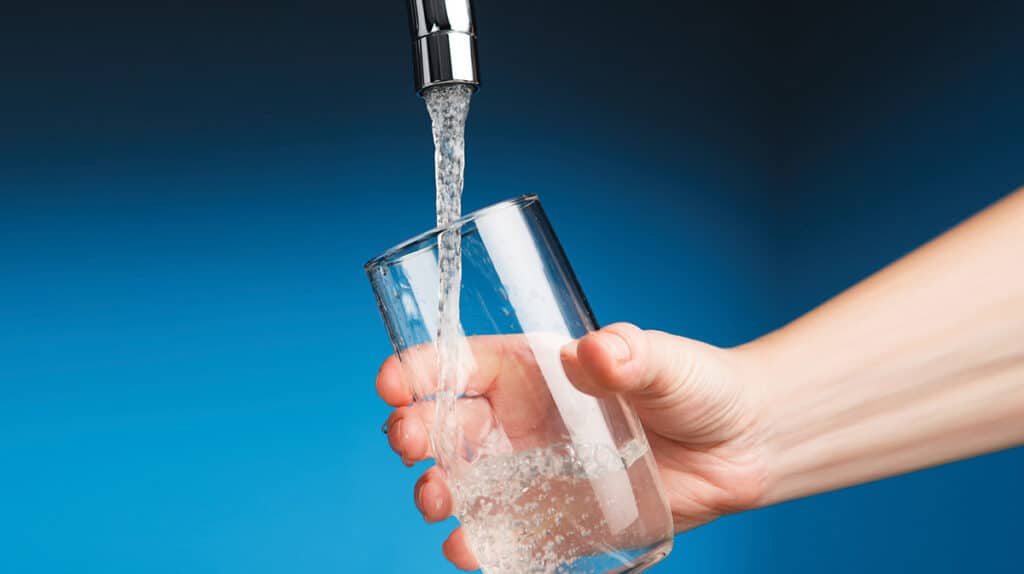What this guide will answer:
- What are the features and benefits of the most popular water purification systems on the market today?
- I’m experiencing specific problems with my home water supply. What can I do to resolve them?
- How do water purification systems work?
- Which water purification solutions make the most sense for my home?
- Should I consult with a water treatment advisor?
- What do I need to consider when purchasing a new water purification system?
- Which chemicals or minerals can impact the taste and smell of water?
- What is hard water and why should it be softened?
Quick-Start Troubleshooting Guide
The most common household water issues and the water treatment solutions to fix them
From bad-smelling water to stains on faucets and appliances, there’s a solution to handle most issues you may confront with your home water supply.

Whole Home Chlorine Filters
May improve the taste of your tap water and reduce the concentration of chlorine and other contaminants in your home’s water supply.
Whole home chlorine filters (also called “whole home carbon filters”) are one of the simplest and most reliable solutions for some of the most common water quality concerns, including bleach smell and taste.
These days, chlorine is added to most municipal water supplies in order to kill micro-organisms, both at the treatment plant and along distribution pipes that bring water into your home. And while chlorine has been used to kill waterborne microbes for decades, it can infuse your water with the unpleasant taste and smell of bleach.
TIP:
While chlorine is still the most common disinfectant used in municipal water supplies, a related compound called chloramine—which combines chlorine and ammonia—has gained popularity with some municipalities. Chloramine can provide longer-term, residual disinfection than chlorine, while also generating fewer by-products.
How they work: Typically installed on the main incoming water line in a basement or utility room, water enters the filter’s housing, percolates through carbon particles, then leaves the filter. Impurities are bound by the carbon, while the resulting purified water flows from the filter to both the hot and cold sides of your household supply.
Choose from two types of whole home chlorine filters:
- Backwashing-type-filters — cylinder-shaped pressure vessels sit on the floor in the basement or utility room.
- Active ingredients: Carbon particles—which look like coarse-ground coffee but are black in colour, not brown—sit loose in the bottom of the filter body.
- Benefits: One filter can handle all the water that flows through an average home for several years before carbon replacement is required. And, with regular maintenance and carbon replacement, a backwashing filter will easily last a very long time.
- A great choice: Coconut carbon—the highest-quality and most effective activated carbon for whole home filters.
- Cartridge-style filters – smaller in size than backwashing filters, but the operating cost is higher (replacement filter cartridges are more expensive than loose carbon for the same duration of filtration activity). These filters are typically point of use and not whole home systems.
- Active ingredients: Carbon particles contained in a cartridge inserted into the filter body.
- Benefits: Most cartridge-style filter bodies can accept more than one type of cartridge.
- A great choice: A variety of cartridges are available to address specific filtration needs, whether you want to remove sediment, tannins or chlorine.
When it comes to installation, it’s best to consult with experts.
Though it’s relatively simple for a licensed plumber to install, you’d be wise to book an in-home session with a water treatment advisor before deciding to have a whole home filter installed. This is especially important because your situation may involve more than just chlorine.
Tips for choosing a whole home chlorine filter
- Consult a water treatment advisor to determine the type of water purification that’s right for you.
- Consider the carbon replacement costs for a backwashing-type filter (which uses loose carbon) vs. a cartridge-style filter system.
Whole Home Chlorine Filters – Features & Benefits
- Can eliminate the chlorine taste and odour from each tap in your house for better tasting and smelling water
- Long-lasting, high-quality activated carbon filter
- Uses a high-quality regenerating valve for optimal filtration performance
- An excellent addition to other Reliance Home Comfort water treatment solutions, such as water softeners

Water Softening Systems
Reduce or eliminate the appearance of mineral build-up on fixtures, tubs, showers and sinks, and help to avoid hazy residue on glassware and silverware
What is hard water, and why does it need to be softened?
Water is considered hard or soft depending on its concentration of dissolved minerals, particularly magnesium and calcium ions. Some of the common reasons why people consider softening their household water supply:
- When water is too hard, it requires more soap for a given cleaning job.
- It can cause mineral build-up on taps, showers, baths and kettles.
Water softening systems come in various forms to meet homeowners’ diverse needs:
- Salt-based softeners – also called “ion exchange water softeners”; effectively replace naturally occurring mineral ions in the water with other ions that don’t cause the same issues as hard water; salt must be added from time to time to recharge the internal resin bed that makes ion exchange happen,
TIP
- gpg – grains per gallon
- mg/L – milligrams per litre
- ppm – parts per million
- mg/mL – milligrams per millilitre
Note: 1 gpg = approx. 17 mg/L
Key Considerations
- Salt consumption: The amount of salt you will need will depend on a variety of things. The salt needs to be added into a compartment in the softener, and the system regenerates automatically based on a pre-set schedule.
- Water usage: All salt-based softening systems use water that’s ultimately sent down the drain to complete the regeneration process.
- Flavour: Many people don’t like the taste of softened water, so they configure at least one cold water tap in the house (usually at the kitchen sink) to be fed with unsoftened water for drinking purposes.
- Bundling potential: If your water is moderately hard and you have a reverse osmosis (RO) system or plan to have one installed, consider a salt-based softener to treat the water before it goes into the RO unit. Pre-softening water may extend the working life of RO filter cartridges.
Tips for choosing a water softening system:
- Consult a water treatment advisor for help in choosing a model that suits your needs.
- Ask about a rental agreement, extended warranty and service contract to avoid any financial surprises.
Water softening systems

Possible Features & Benefits:
Stable, reliable and economical technology for salt-based softeners
Use less soap to get a good lather while doing away with built-up residue on sinks, bathtubs, kettles appliances, and more
Keep your fabrics brighter for longer
Enjoy the feel of softened water when bathing and taking a shower
Iron/Manganese Filters
Eliminate the metallic taste, improve water clarity and odour, and reduce yellow, brown or black stains on plumbing fixtures, appliances and laundry
Iron and manganese compounds occur naturally in the groundwater of some areas;
Water with excess iron/manganese can appear clear at first but then develop colour and cloudiness after exposure to oxygen. The oxygen causes both the iron and manganese to settle in rust-like particles at the bottom of drinking glasses or pitchers, and these substances can also affect the taste of water.
Did you know?
As little as 0.3 mg/L of iron and 0.05 mg/L of manganese in water can cause staining on household plumbing fixtures.
Iron causes reddish-brown stains, black residue come from manganese.
Choose from several options to remove the majority of the iron and/or manganese in your water:
- Iron/manganese filtration systems – can remove higher iron concentrations (more than 5 mg/L). These should be installed in the water supply line ahead of any softening systems, as even fully dissolved elements can shorten the lifespan of the resin bed used in salt-based softeners if concentrations are too high.
How they work:
One of the simplest types of iron filters includes a single cylindrical tank with air in the top and a filter media at the bottom. Iron and manganese in the water are oxidized by spraying it through the air in the tank. This causes the iron and/or manganese to drop out of the solution; the resulting rust-like particles are filtered out by the media at the bottom of the tank as the water flows through it on its way to your faucet and/or fixtures.
These systems automatically backwash every three or four days, flushing the precipitated iron/manganese out and down the drain.
Tip for choosing an iron/manganese removal system
- Always consult a water quality advisor before buying an iron/manganese filter, as it’s vital to understand your home’s water chemistry in order to choose the right model for your needs.
Iron/manganese filters – features & benefits:
- Improve the clarity of your water
- Reduce or eliminate metallic taste and odour in water you consume
- Safe and effective prevention of sink, tub and toilet staining
- Could help to extend the life of water-consuming equipment, fixtures and appliances

Reverse Osmosis (RO) Systems
Could help Improve the purity and taste of your home’s tap water
RO purification systems are designed to transform ordinary tap water into purified water.
The volume of water produced by most domestic RO systems is not sufficient to supply an entire house. Rather, typical RO systems are positioned under the kitchen countertop and have a dedicated faucet for drinking, cooking and washing dishes.
The pore size of a typical RO filter is 0.0001 micron.
By comparison, a red blood cell measures 5 microns across and a human hair is about 75 microns in diameter.
How they work
Key to the RO treatment process is the fact that water molecules are small when compared with many other molecules. RO systems separate and trap undesirable substances from water as it’s pushed through a series of very fine membranes under pressure, leaving you with clean, filtered water.
RO systems typically come in two categories, which influences the type of filter mechanism used:
- Proprietary RO systems – use specific filters made by one particular company for their devices.
- Non-proprietary systems – use generic RO filters, made available by various suppliers to fit a range of different brands, often at a lower cost than proprietary filters.
Key considerations:
- Output and your water needs: All RO systems have a maximum output of filtered water; Consult with a water treatment advisor to select the right size of system for your home.
- Water usage: It can take 4 L of tap water sent down the drain to create 1 L of purified water using a RO system. This depends on several factors, including the system design, the temperature of the incoming water, and the pressure at which the water is delivered. (Note: If your household water pressure is 40 psi or lower, an auxiliary pump may be required to boost pressure enough for the RO system to operate effectively.)
- Filter changes: Filters should be changed on a regular basis as prescribed by the manufacturer.
- Bundling potential: Since RO systems offer such fine filtration, they usually come packaged with other filters for optimal water quality and purity. For instance, RO systems often include a sediment filter to protect membranes from being overloaded by large particles that may be present in the water. Carbon filtration is also often included as the last part of RO systems.
TIP
RO systems can’t remove hydrogen sulphide (the chemical that gives sulphur water its rotten egg smell). Its presence in your water supply can shorten the life of RO membranes.
Tip for choosing a RO system:
- Ask about the warranty period and coverage before you decide which unit to rent or buy.

- Reliable production of filtered water removes a variety of common contaminants for cleaner, clearer and better-tasting water
- Large volume of daily output
- Quiet operation with countertop faucet design
Ceramic Filtration Systems
A simple, low-cost way to remove contaminants from drinking water
Most popular in seasonal homes, cottages and camps with private water systems (e.g., wells), ceramic-based systems use very fine, stone-like micro-filtration cartridges to separate contaminants from the water stream. Good ceramic filters capture substances down to 0.2 microns in diameter.
How they work:
The filter canister is connected to the incoming cold-water supply pipe, typically underneath a sink counter. The canister is mounted on the inside of the cabinet, with the drinking/cooking water output of the filter dispensed through a small, secondary tap that’s typically situated next to the main faucet.
Key considerations:
- Output and your water needs: Ceramic filters flow about 1 gallon/minute (about 4 L/minute) when new, but flow rate slows as residue builds up on the outside of the cylindrical filter itself.
- Maintenance: Shut off the water supply and open the filter body, remove the ceramic cartridge and scrub its outside surface with a clean, soft scouring pad (like the type used on cookware) or a clean toothbrush under running water. Avoid soaps and detergents or rough materials like steel wool, which can render your filter unusable. Reinstall the cartridge in the filter body, then turn the water supply back on.
- Filter changes: Typical ceramic cartridges can be cleaned up to 100 times before needing to be replaced.
TIP
The period between required cleanings varies depending on the amount and purity of the water being filtered. You’ll know cleaning is required when the flow of water from the filter tap becomes too slow.
Tip for choosing & using a ceramic filter system:
- An additional hole will need to be drilled in your countertop to accommodate a ceramic filter tap.
Whole Home Sediment Filters
Remove sediment and tannin discolouration from your water and prevent water purification equipment and the screens on taps and fixtures from clogging
If your water is cloudy or contains residue that clogs the filters in other parts of your plumbing system— including your tankless water heater, water-dispensing fridge, washing machine or other appliances—then a whole home sediment filter might be a good solution for you.
How they work:
Used most often in homes supplied by a well, lake or river, whole home sediment filters remove relatively large suspended solids from household water and are typically the first device installed on the incoming water line in your home.
Tips for choosing a whole home sediment filter
- The larger the filter, the longer it will last between cleaning sessions.
- Regular maintenance requires a visual inspection of the condition of the filter element, typically by looking through a clear filter housing. Consider placing the filter where its filter is as easy as possible to inspect, remove and replace.
- As you assess different models, consider the price and availability of replacement filter cartridges.
With so many great and effective water purification systems and solutions available on the market today, your first step to finding the right solution for your household is to determine the chemical makeup of your water, your daily water consumption needs, and the changes you’d like to make in your water supply.
A Reliance Home Comfort® Water Purification Advisor can help determine what water purification solution is right for your home and family’s needs.

